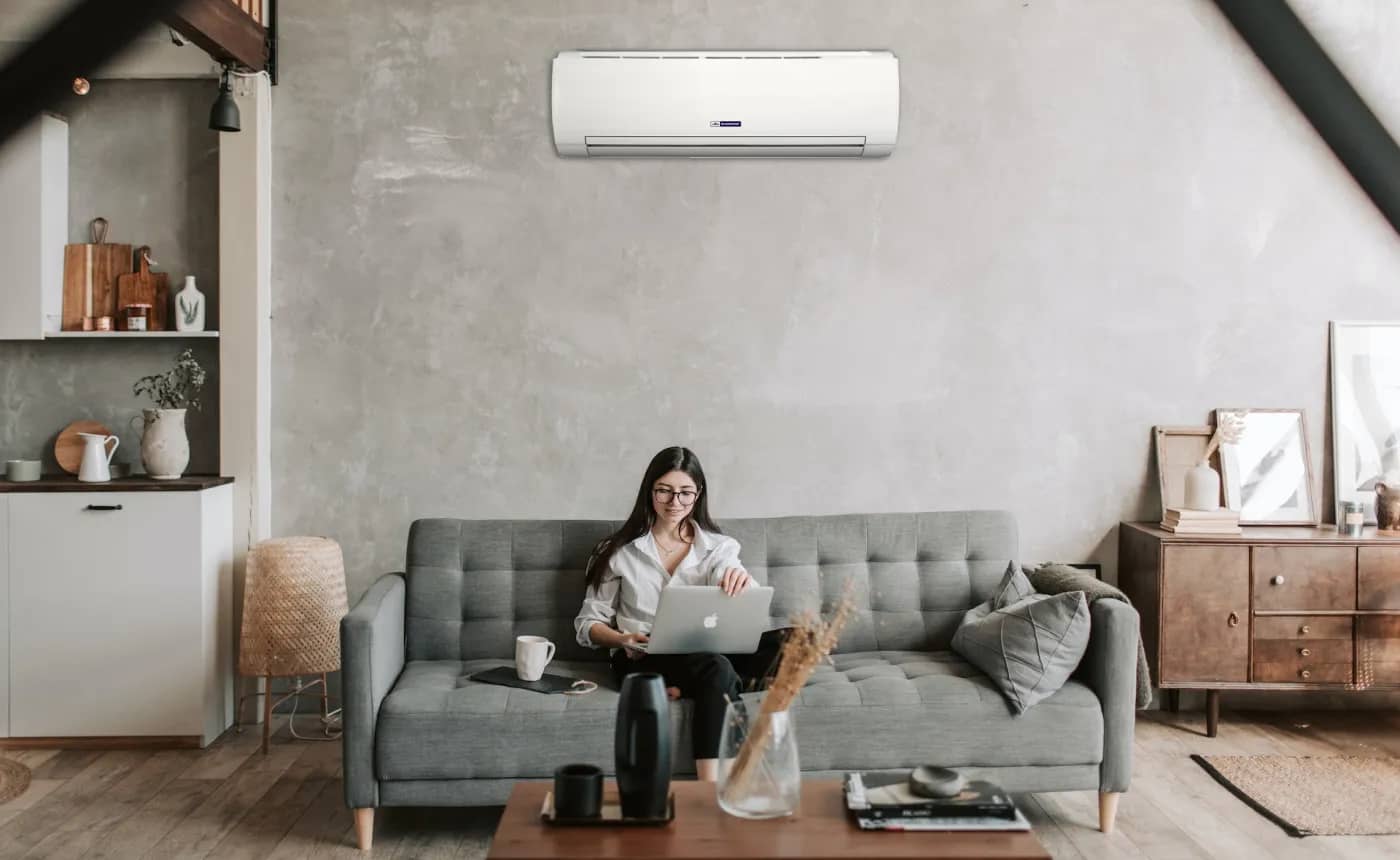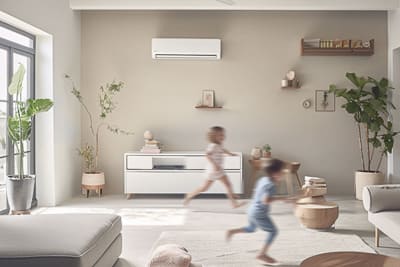
You’ve researched and decided that a mini-split system is the best way to heat and cool your home or office. But one thing still concerns you: How can you make your indoor unit look less noticeable? If hiding a ductless mini-split is something you’re considering, we have buying tips and creative hacks to share.
KEY TAKEAWAYS
- While ductless mini-splits continue to rise in popularity, some are unsure about the indoor unit’s visual appearance.
- Concealing a mini-split is possible while maintaining its heating and cooling efficiency.
- Before you decide to conceal a mini-split indoor unit, it’s important to know its advantages and disadvantages.
While ductless mini-split air conditioners have many advantages over traditional HVAC systems, some consider their visible presence in the living space a disadvantage.

However, continued advancements in design and aesthetics have led to sleeker and more discreet indoor units, allowing them to blend seamlessly with various interior styles and minimize their visual impact.
Still, if you want to keep your ductless mini-split indoor units out of the spotlight, we have some creative ways to help them blend in.

To Hide or Not to Hide (a Ductless Mini Split)
While mini-splits offer undeniable efficiency and flexibility, there are instances when homeowners may wish to conceal them from view.
Despite their many advantages, indoor units’ appearance can sometimes clash with interior design aesthetics or architectural elements.
In spaces where visual harmony is crucial, such as traditional or historically themed rooms, exposed indoor units might disrupt the overall ambiance.
Additionally, when homeowners prioritize maintaining a clean, minimalistic, or uncluttered appearance, visible indoor units can introduce a sense of disorganization or distraction.
In such instances, concealing ductless mini splits can help align the cooling and heating solution with the desired interior aesthetics, creating a more unified and visually pleasing environment that complements the overall design.
7 Reasons to Hide a Ductless Mini-Split
Here are some examples of situations when homeowners might choose to hide their ductless mini-split interior unit(s):

Historic Homes or Period Interiors:
In homes with historic or period-specific interiors, exposed modern-looking indoor units could disrupt the authenticity of the design. Concealing the units allows homeowners to preserve the space’s historical charm and visual integrity.
Minimalist or Modern Spaces:
Some homeowners prefer clean, minimalist, modern interior designs with sleek lines and minimal visual clutter. Concealing ductless mini splits helps maintain such spaces’ simplicity and prevents the indoor units from becoming focal points.
Open Concept Living Areas:
Open-concept living areas emphasize continuous flow and unobstructed sightlines. Concealing mini splits can contribute to the roomy feel by keeping the indoor units from breaking up the visual continuity.
High-End Interiors:
Aesthetic cohesion is essential in luxury homes or upscale interiors. Concealing ductless mini-splits allows for seamless integration of the HVAC system while maintaining the premium quality of the overall design.
Artistic or Statement Walls:
If a room features a striking mural, artwork, or a statement wall, exposed indoor units might detract from that focal point. Concealing those units ensures that the visual focus remains on the intended centerpiece.
Bedrooms or Relaxation Spaces:
Many homeowners seek a serene atmosphere in their bedrooms and relaxation areas. Concealing indoor units can reduce visual distractions, creating a more calming environment.

Commercial Spaces:
Businesses aiming for a polished and professional appearance may conceal indoor units in customer-facing areas to maintain a consistent brand image and a clean visual presentation.
In each case, concealing ductless mini-splits helps align the HVAC solution with interior design goals and creates a pleasant atmosphere.
Choices, Choices: First, Choose the Right Mini Split Type for You
Before you start thinking about how to hide your mini-split, consider what type of indoor air handler will work best for the space you want to heat or cool.

Indoor mini split units continue to improve in performance and style, and many manufacturers now offer a variety of types.
Each type of mini-split air handler accommodates different preferences and room sizes and has different installation requirements. Here are the most common types of indoor units from which you can choose:
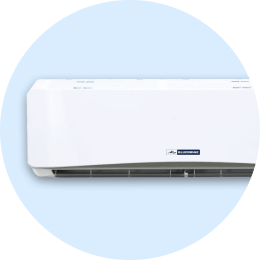
High-Wall Units
High-wall-mounted air handlers are the most common indoor mini-split units and have the widest range of options, including fully DIY mini-split systems.
These units are typically installed high on a room’s wall and provide efficient heating and cooling throughout the space.
A high-wall mini-split is compact, easy to install, and offers adjustable louvers directing airflow.
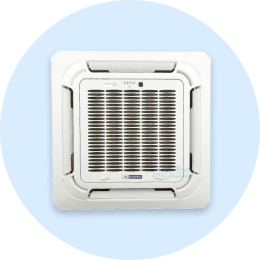
Ceiling Cassette Units
Ceiling cassettes are mounted within the ceiling, making it discreet and ideal for areas with limited or no wall space.
Traditional (square) ceiling cassettes distribute air evenly in all directions, creating uniform comfort throughout the room. Some brands offer slim cassettes that easily fit between standard ceiling joists, simplifying installation.
These units are popular in commercial settings and open-floor-plan homes, providing good airflow throughout the space.

Low-Wall Units
A mini split low-wall console is placed at floor level, sometimes below windows, providing efficient heating and cooling.
Low-wall units are great for rooms with limited wall space or specific architectural requirements.
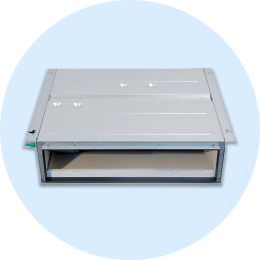
Concealed Duct Units
Though mini-splits are ductless systems by design, a mini-split concealed-duct unit can serve up to three rooms using a network of flexible ducts concealed in an attic, basement, or crawl space.
This innovative design maintains the efficiency and performance of a ductless mini-split while incorporating the benefits of concealed air distribution through ductwork.
A concealed duct mini-split is ideal for those who want hidden air distribution through central-air-like vents.
Once you’ve determined which mini-split air handler is right for you and your space, you can consider creative ways to make it less obvious.

8 Clever Ways to Hide Your Ductless Mini Splits
Integrating ductless mini-split systems seamlessly into your living space requires some creative thinking.
Because these units must freely circulate hot and cool air throughout a space, it’s important to ensure that your mini-split can function properly, regardless of how you style it.
Here are various strategies that provide both functionality and concealment:
- Use a Ceiling Unit: Opt for a ceiling-mounted indoor unit to keep it inconspicuous. This placement allows the unit to blend into the overhead space, avoiding visual interruption in the room’s design.
- Consider a High-Wall Unit Above a Doorway or Window: Install the indoor unit above a doorway or window frame. This high placement helps conceal the unit while utilizing the available vertical space.
- Built-In Cabinetry or Furniture: Incorporating the indoor unit within custom cabinets or furniture serves a dual purpose. The unit remains hidden, and the furniture adds functional storage or display space, seamlessly integrating the HVAC system into the room’s design.
- Recessed Wall Units: Recessing the indoor unit into a wall creates a streamlined and discreet appearance. The unit becomes a seamless part of the wall, maintaining the room’s visual flow while delivering efficient heating and cooling.
- Use Decorative Screens or Window Treatments: Enhance the aesthetics of your space by using decorative screens or window treatments to camouflage the indoor unit. These additions conceal the unit and contribute to the overall decor.
- Consider Artwork or Mirrors: Place artwork or mirrors alongside the mini-split to transform that wall into a design feature. The combination of artwork or mirrors and the concealed unit adds sophistication to the room.
- Install Floating Shelves: Strategically position floating shelves to shield the indoor unit from direct view while maintaining airflow. These shelves can serve as functional display areas while discreetly concealing the unit.
- Place the Unit Behind Furniture: Strategically arrange furniture, such as bookshelves, cabinets, or sofas, to obstruct sightlines to the indoor unit. This approach not only conceals the unit but also optimizes space utilization.
These creative strategies empower you to integrate your ductless mini-split system into your decor while achieving optimal heating and cooling. By concealing your indoor unit using these inventive approaches, you can enjoy a harmonious living space without compromising comfort or aesthetics.
Top 11 Considerations When Hiding a Ductless Mini Split Unit
Hiding a ductless air conditioner involves thoughtful planning and creative solutions to seamlessly integrate the unit into your living space. Here are the top 10 things to consider when hiding a ductless mini-split system:
- Think About Interior Design Aesthetics: Consider the existing interior design style and color scheme. The concealed solution should blend harmoniously with the decor.
- Think About Architectural Elements: Assess the room’s architectural features, such as windows, doorways, and ceiling height. Choose a concealed location that complements the space.
- Consider Airflow and Performance: Ensure the mini split’s concealed placement doesn’t obstruct airflow or hinder its heating and cooling capabilities.
- Choose Optimal Placement: Identify areas where the unit can be hidden effectively without compromising its operational efficiency.
- Zero in on Zoning and Functionality: Plan the unit’s placement to maintain its ability to freely distribute the conditioned air to the desired zones or rooms.
- Think About Ease of Access: Consider future maintenance and service needs. Ensure the concealed unit remains accessible for cleaning, filter replacement, and repairs.
- Focus on Furniture Arrangement: Arrange furniture strategically to shield the mini split from direct view while maintaining comfortable airflow.
- Consider Custom Cabinetry: Explore integrating the mini split into custom-built cabinetry, which can provide concealment and functional storage.
- Make Some Decorative Decisions: Investigate decorative screens, window treatments, artwork, or mirrors that can cleverly camouflage the unit while adding aesthetic value.
- Decide if You Need Professional Installation: Consider working with experienced HVAC professionals specializing in mini split installations. They can provide expert advice on optimal concealment strategies.
- Prioritize Structural Considerations: Ensure the concealed location can accommodate the unit’s weight and dimensions without compromising its structural integrity.
By carefully addressing these considerations, you can effectively hide a ductless mini-split system while maintaining the comfort, aesthetics, and functionality of your living space.
Consulting with one of Alpine Home Air’s HVAC professionals or an interior designer can provide valuable insight into ensuring the successful integration of your mini split unit into your home.
When You Are Ready to Install
When concealing a ductless mini split, homeowners can choose between seeking professional assistance or pursuing a do-it-yourself (DIY) approach. Both options offer unique advantages, and the decision ultimately depends on your comfort level, available time, and desired outcome.
Professional Assistance
Engaging the expertise of HVAC air conditioner professionals and interior designers can ensure seamless integration of the mini-split unit into your living space. Here are some reasons why you might opt for professional assistance:

Custom Solutions:
HVAC professionals can evaluate your home’s layout, airflow patterns, and architectural features to design custom concealment solutions that optimize aesthetics and performance.

Experience and Expertise:
Professionals have experience working with mini-split systems and understanding their technical requirements. They can recommend the best placement and concealment methods for efficient operation.

Access to Resources:
HVAC experts have access to various materials, tools, and techniques to create discreet and effective concealment solutions that blend seamlessly with your interior.
DIY Options
If you enjoy hands-on projects and want to take control of the concealment process, DIY options are available. Here’s why you might consider a DIY approach:
Creative Freedom: DIY allows you to experiment with creative ideas and personal touches to create a custom concealment solution that aligns with your design preferences and meets your mini split cost expectations.

Cost Savings: DIY projects can potentially save on labor costs. You can choose budget-friendly materials and adapt existing furniture or decorative elements to conceal the mini split.
Sense of Accomplishment: Completing a DIY concealment project can be a rewarding experience, giving you a sense of achievement and a unique feature in your home.
Resources are readily available online if you’re leaning towards a DIY approach.
You can find tutorials, step-by-step guides, and design inspiration on blogs, YouTube, and home improvement websites.
While DIY projects offer creative freedom, achieving professional-level results may require more time and effort.

Whether you choose professional assistance or DIY, the goal remains the same: a mini-split unit that enhances the aesthetics of your space while maintaining optimal heating and cooling performance.
Whatever path you take, Alpine can support your ductless mini-split journey with a wide range of products and expert guidance.
When You Are Ready…Alpine is, Too!
Whether you’re ready to buy a ductless mini-split or want to consider more heating and cooling options, let Alpine help!

We are a dedicated HVAC company with over 20 years of experience. Our team of experts is ready to help you find the best solution.
Whether you are unsure if a ductless unit is right for you or need help choosing between hiding your indoor unit behind a picture frame or a built-in cabinet, Alpine has the experience and the experts to help you navigate it all.
Do you want to learn more? Reach out to us today!

